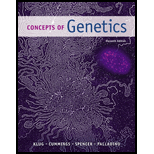
Concept explainers
(a)
To determine:
That how the idea emerges that the promoter and enhancer sequences control the initiation of transcription in eukaryotes
Introduction:
The gene expression is highly controlled starting at chromatin modification to protein stability. The modification in the DNA sequences and the histone proteins serves the major factor that influences the gene expression. The promoter sequences and the enhancer sequences are the initiating sequences present at the upstream of the DNA sequences. Modification in these sequences such as DNA methylation suppresses the gene expression that results in the silencing of the genes.
(b)
To determine:
That how the idea emerges that the eukaryotic transcription factors bind to DNA sequences at or near promoter regions
Introduction:
The transcription is the process in the encoding of genes to produce the mRNA that is complementary to that of gene sequences. It consists of three steps namely initiation, elongation and termination. The RNA polymerase serves as the major enzyme which carries outs the transcription process. Other transcription factors also play an important role in this process namely sigma factor, TFIIA, TFIIB, TFIIC, etc.
(c)
To determine:
That how the idea emerges that the double-stranded RNA molecules can control gene expression
Introduction:
There are several double-stranded RNA is involved in the regulation of gene expression. They are called as non-coding RNA since it does not code for any proteins. Examples are siRNA, miRNA, piRNA, etc. Small interfering RNA (siRNA) is the double-stranded noncoding RNA involved in the gene regulation by RNA interference mechanism. The enzyme Dicer cleaves the double-stranded siRNA into short single-stranded RNA that binds to the complementary base pairs within the genome to be silenced and denatures the mRNA.
Want to see the full answer?
Check out a sample textbook solution
Chapter 17 Solutions
Concepts of Genetics (11th Edition)
 Human Anatomy & Physiology (11th Edition)BiologyISBN:9780134580999Author:Elaine N. Marieb, Katja N. HoehnPublisher:PEARSON
Human Anatomy & Physiology (11th Edition)BiologyISBN:9780134580999Author:Elaine N. Marieb, Katja N. HoehnPublisher:PEARSON Biology 2eBiologyISBN:9781947172517Author:Matthew Douglas, Jung Choi, Mary Ann ClarkPublisher:OpenStax
Biology 2eBiologyISBN:9781947172517Author:Matthew Douglas, Jung Choi, Mary Ann ClarkPublisher:OpenStax Anatomy & PhysiologyBiologyISBN:9781259398629Author:McKinley, Michael P., O'loughlin, Valerie Dean, Bidle, Theresa StouterPublisher:Mcgraw Hill Education,
Anatomy & PhysiologyBiologyISBN:9781259398629Author:McKinley, Michael P., O'loughlin, Valerie Dean, Bidle, Theresa StouterPublisher:Mcgraw Hill Education, Molecular Biology of the Cell (Sixth Edition)BiologyISBN:9780815344322Author:Bruce Alberts, Alexander D. Johnson, Julian Lewis, David Morgan, Martin Raff, Keith Roberts, Peter WalterPublisher:W. W. Norton & Company
Molecular Biology of the Cell (Sixth Edition)BiologyISBN:9780815344322Author:Bruce Alberts, Alexander D. Johnson, Julian Lewis, David Morgan, Martin Raff, Keith Roberts, Peter WalterPublisher:W. W. Norton & Company Laboratory Manual For Human Anatomy & PhysiologyBiologyISBN:9781260159363Author:Martin, Terry R., Prentice-craver, CynthiaPublisher:McGraw-Hill Publishing Co.
Laboratory Manual For Human Anatomy & PhysiologyBiologyISBN:9781260159363Author:Martin, Terry R., Prentice-craver, CynthiaPublisher:McGraw-Hill Publishing Co. Inquiry Into Life (16th Edition)BiologyISBN:9781260231700Author:Sylvia S. Mader, Michael WindelspechtPublisher:McGraw Hill Education
Inquiry Into Life (16th Edition)BiologyISBN:9781260231700Author:Sylvia S. Mader, Michael WindelspechtPublisher:McGraw Hill Education





